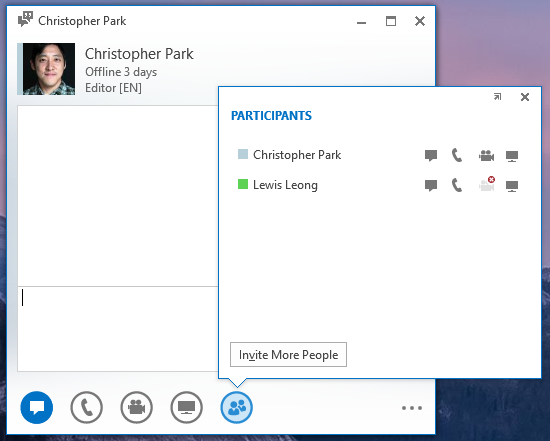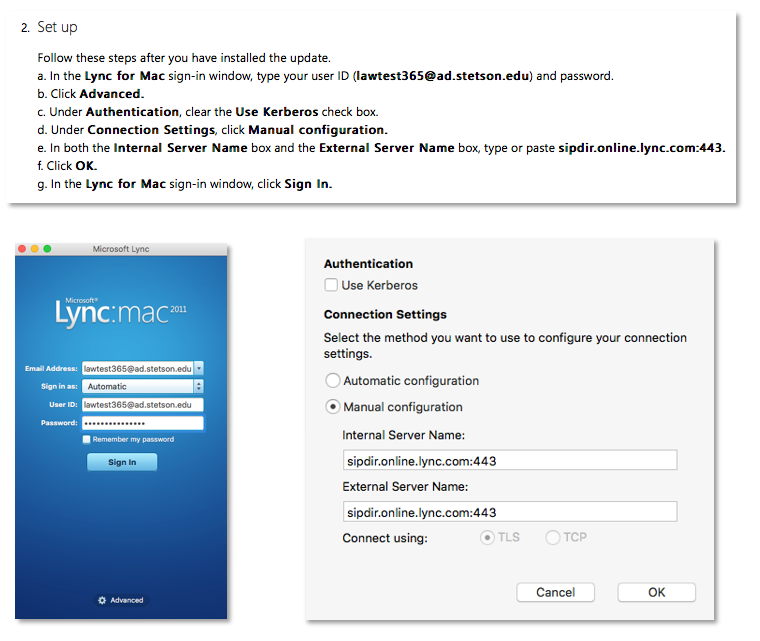Lync Microsoft Office Herunterladen For Mac
Lync 2013 Lync 2013 now supports audio and video calls in a remote desktop environment, for example, Virtual Desktop Infrastructure (VDI) environment. You can connect an audio or video device to your local computer and then connect to a virtual machine that is running Lync. Once you connect to the virtual machine and sign-in to Lync, you can then make and receive audio or video calls. What do you want to know about?
Which features are not supported when Lync is in a VDI environment? The following features are not supported when you are using Lync 2013 in a VDI environment:. The Audio Device and Video Device tuning pages are not available. Multi-view video is not supported.
Recording of conversations is not supported. The Call Delegation and Response Group Agent Anonymization features are not supported. Joining meetings anonymously (that is, joining Lync meetings hosted by an organization that does not federate with your organization) is not supported. Using the Lync VDI plug-in along with a Lync Phone Edition device is not supported How to set-up an audio and video device? When Lync detects that you are using Lync in a remote desktop environment, it prompts you to enter your credentials so that Lync can use the audio and video device that’s connected to your computer. To connect your audio and video device, do the following:.
Enter your credentials when prompted, select Save Password, then click OK. The Lync status bar will update when you have successfully connected your audio and video device. Note: Your audio or video device will not connect if your Lync sign-in information is incorrect or you click Cancel when you are prompted for your Lync sign-in information. When this happens sign out of Lync, and then sign in again with your correct sign-in information. How to check if my audio or video device works with Lync?
There are two easy ways to do this: From the Lync Contacts list, check the status bar on the lower right. If you see a green check mark, then your audio and video devices are connected to Lync successfully.

If you are using a Lync-certified audio device and you see your presences status on the LED display of the device, then it’s working correctly. I have multiple headsets connected to my local computer, how do I check which one I use with Lync?. On Lync status bar located check the Audio Device icon on the lower-left corner, it will list the device Lync is using. You can also check by, making a Lync test call and then check which audio device is being used by Lync. How do I adjust by speaker volume?.
When you are in a call, click the Audio icon, and then click the Device tab. Use the slider bar to adjust your volume. Note: To mute your speakers, click the Speaker icon next to the volume slider, and then click the Mute icon. How do I adjust my microphone gain level? To adjust your microphone gain level, do the following on our computer:.
On your system tray, right click the Speaker icon, and then select Recording Devices. Select your device from the list and then click Properties. Click the Levels tab, and use the slider bar adjust your microphone gain level. How do I switch from my headset to a speaker phone during a call? Lync supports all HID (Human Interface Device) commands from Lync compatible devices. If you have a HID connected to your local computer, push the speaker button on your speakerphone device to move the call from your headset to the speakerphone.
16.0.8625.2127 / 17 November 2017; 12 months ago ( 2017-11-17), and, and Website Skype for Business (formerly Microsoft Office Communicator and Microsoft Lync) is an used with or with Skype for Business Online (available with ). Skype for Business is.
On 11 November 2014, announced that Skype for Business would replace Lync in 2015. The latest version of the communication software combines features of Lync and of the consumer software. There are two user interfaces – organizations can switch their users from the default Skype for Business interface to the Skype for Business (Lync) interface. In September 2017, Microsoft announced that would replace Skype for Business eventually. On May 20, 2018, Microsoft retired Skype for Business for.
Contents. History Microsoft released Office Communicator 2007 to production on 28 July 2007 and launched it on 27 October 2007. It was followed by Office Communicator 2007 R2, released on 19 March 2009. Microsoft released the successor to Office Communicator, Lync 2010, on 25 January 2011. The full-featured desktop version of the client requires, or with Service Pack 2 or newer.
Lync 2010 was released for the, and platforms in December 2011. Lync 2010 was succeeded by Lync and Lync Server 2013, which were released in 2012. On 11 November 2014, Microsoft announced that Lync would be replaced by Skype for Business in 2015, which would combine features of Lync and the consumer software. In April 2015, Microsoft officially launched Skype for Business. On 22 September 2015, Skype for Business 2016 was released alongside. On 27 October 2016, the Skype for Business for Mac client was released. Broadcom netxtreme bcm5755m drivers for mac free.
On 7 September 2017, users began noticing a message that stated 'Skype for Business is now '. This was confirmed on 25 September 2017, at Microsoft's annual Ignite conference. Features The Basic features of Skype for Business include:.
(VoIP). inside the client software Advanced features relate to integration with other software:. Availability of contacts based on contacts stored in a. Users can retrieve contact lists from a local directory service such as Microsoft Exchange Server. can show if other people are working on the same document. All communication between the clients takes place through a.
This makes communications more secure, as messages do not need to leave the corporate intranet, unlike with the Internet-based. The server can be set to relay messages to other instant messaging networks, avoiding installation of extra software at the client side. A number of client types are available for Microsoft Lync, including mobile clients.

Uses as the basis for its client communication protocol. Offers support for and to encrypt and secure signaling and media traffic. Allows sharing files Note: With the release of Lync Server 2013 in October 2012, a new collaboration feature 'Persistent Group Chat' which allows multi-party chat with preservation of content between chat sessions was introduced. However, only the native Windows OS client and no other platform supports this feature at this time. The main new features of this version are the addition of real-time multi-client capabilities, (which allow teams of people to see and simultaneously work on the same documents and communications session). Lync implements these features as follows:.
Collaboration through Whiteboard documents, where the participants have freedom to share text, drawing and graphical annotations. Collaboration through documents, where the participants can control and see presentations, as well as allow everybody to add text, drawing and graphical annotations. Polling lists, where Presenters can organize polls and all participants can vote and see results. Desktop sharing, usually by allowing participants to see and collaborate on a Windows screen. Windows applications sharing, by allowing participants to see and collaborate on a specific application.
All collaboration sessions get automatically defined as conferences, where clients can invite more contacts. Conference initiators (usually called 'organizers') can either promote participants to act as presenters or demote them to act as attendees. They can also define some basic policies about what presenters and attendees can see and do. Deeper details of policy permissions are defined at server level. Following Microsoft's acquisition of Skype in May 2011, the Lync and Skype platforms could be connected, but sometimes only after lengthy provisioning time. Extensions Lync uses a number of extensions to the SIP/ instant-messaging protocol for some features.
As with most instant-messaging platforms, non-Microsoft instant-messaging clients that have not implemented these publicly available extensions may not work correctly or have complete functionality. Lync supports and IM to other popular instant message services such as AOL, Yahoo, MSN, and any service using the protocol. Text instant-messaging in a web browser is available via Lync integration within Exchange Outlook Web App. Although other IM protocols such as and do have wider support by third-party clients, these protocols have been largely reverse-engineered by outside developers. Microsoft does offer details of its extensions on and provides an kit to help developers build platforms that can interoperate with Lync Server and clients. Clients As of May 2018, the following Skype for Business clients are available:.
Windows and macOS: Included with Office 365. Linux by TEL.RED.
iOS: Microsoft app in iTunes app store; alternative client by TEL.RED. Android: Microsoft app in Google Play; alternative client by TEL.RED. See also. Office support. Retrieved 2 November 2016. Retrieved 2 November 2016.

^ Pall, Gurdeep (11 November 2014). Office Blogs.
Retrieved 11 November 2014. Retrieved 3 September 2015. Retrieved 2017-09-26. Lync Team Blog.
Microsoft Corporation. 28 July 2007. Retrieved 25 October 2011. Retrieved 25 October 2011. Microsoft Download Center.
Microsoft Corporation. Retrieved 9 December 2010.
20 December 2011. Hernandez, Pedro (14 April 2015). Skype for Business Team (27 October 2016).
Lync Microsoft Office Herunterladen For Mac 2011 Free
Foley, Mary Jo. Retrieved 2017-09-26. Archived from on 19 October 2007. Retrieved 10 October 2007. Retrieved 15 August 2008. Microsoft TechNet.
Retrieved 15 May 2008. Retrieved 1 January 2017. Retrieved 22 November 2015. Retrieved 17 April 2016. Retrieved 31 December 2015. Retrieved 17 April 2016. Retrieved 1 January 2017.
External links.